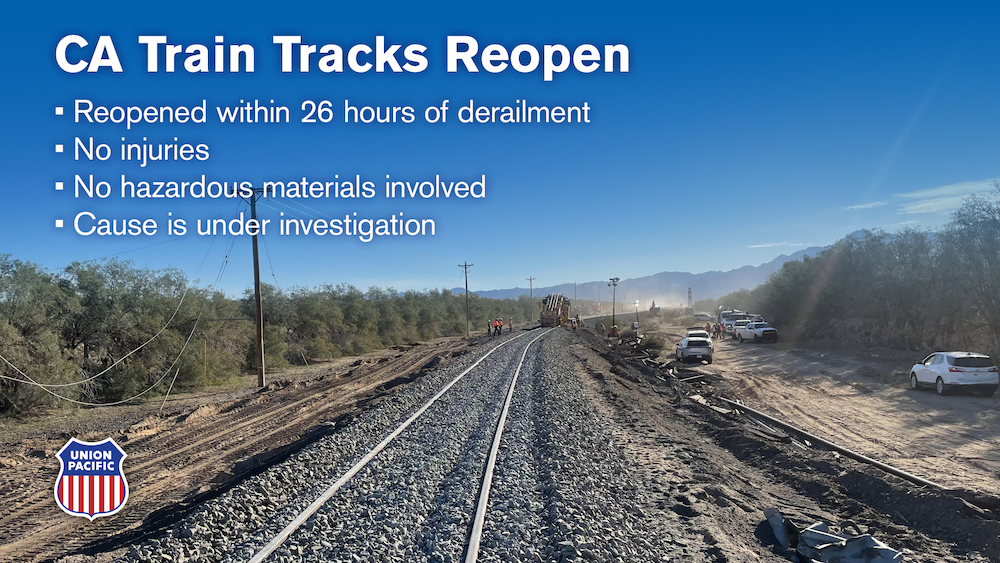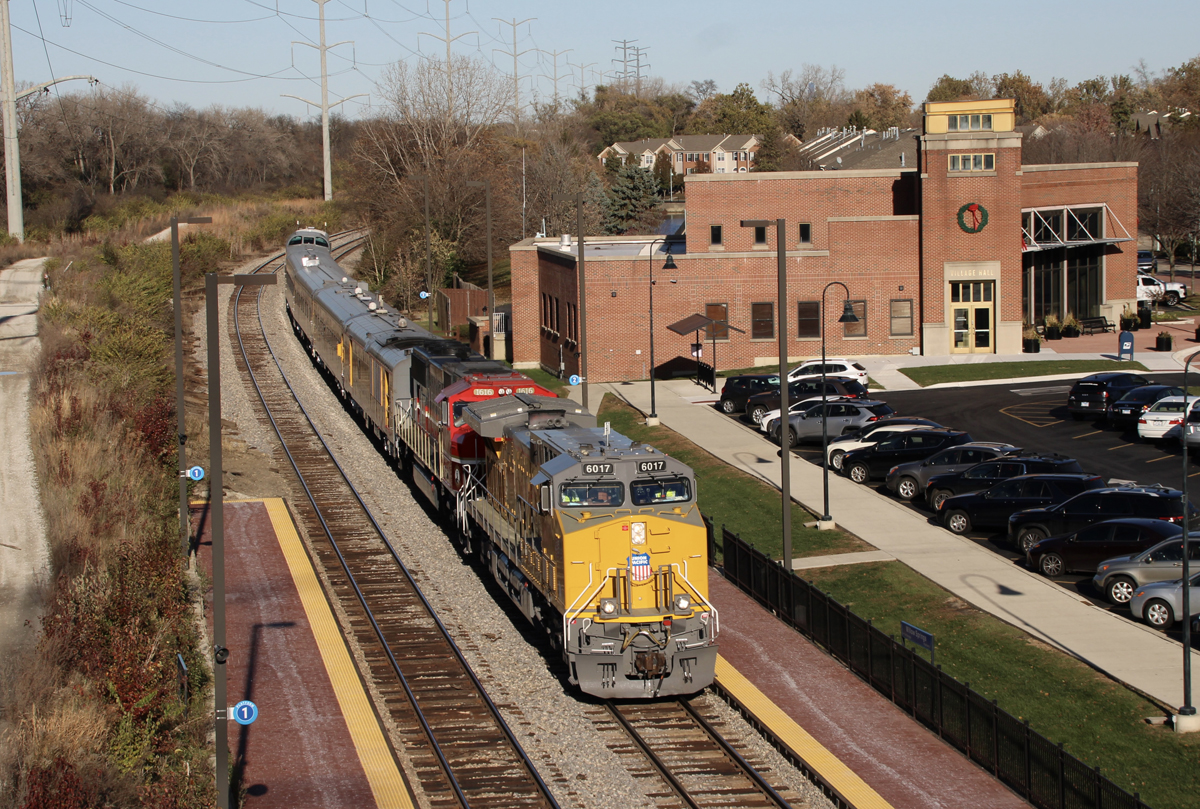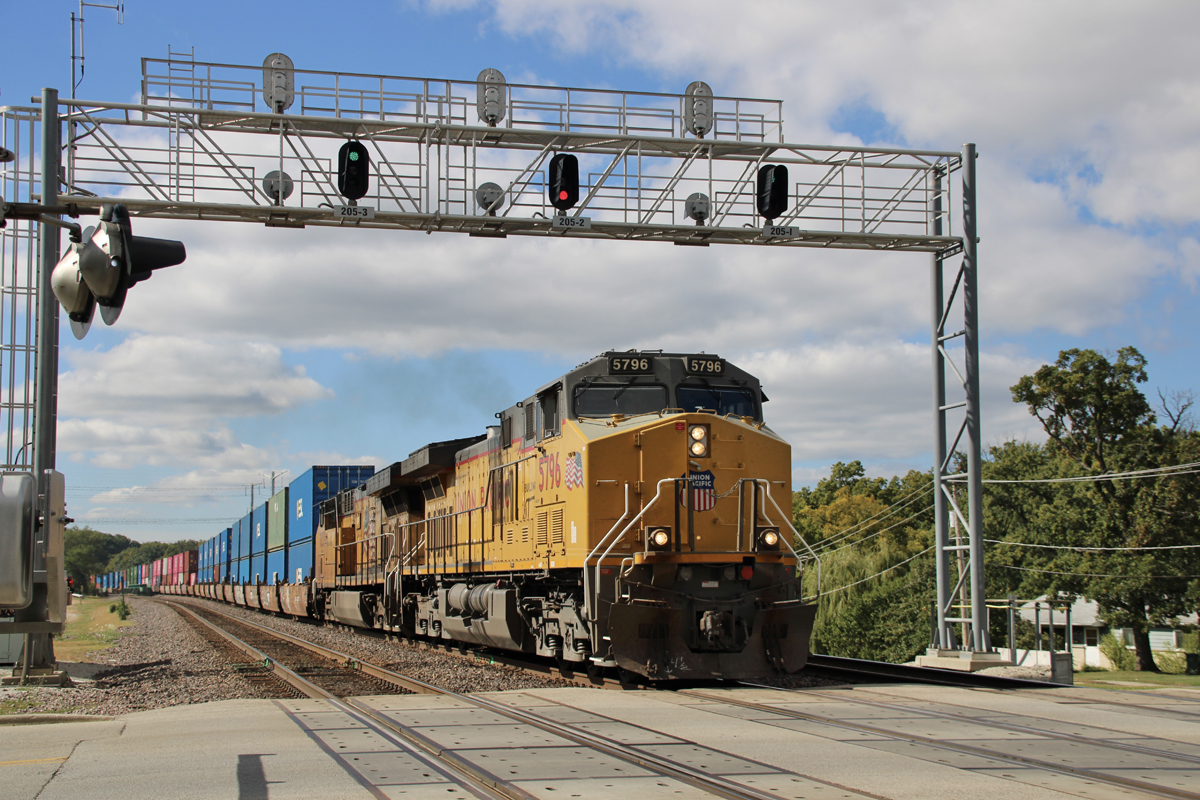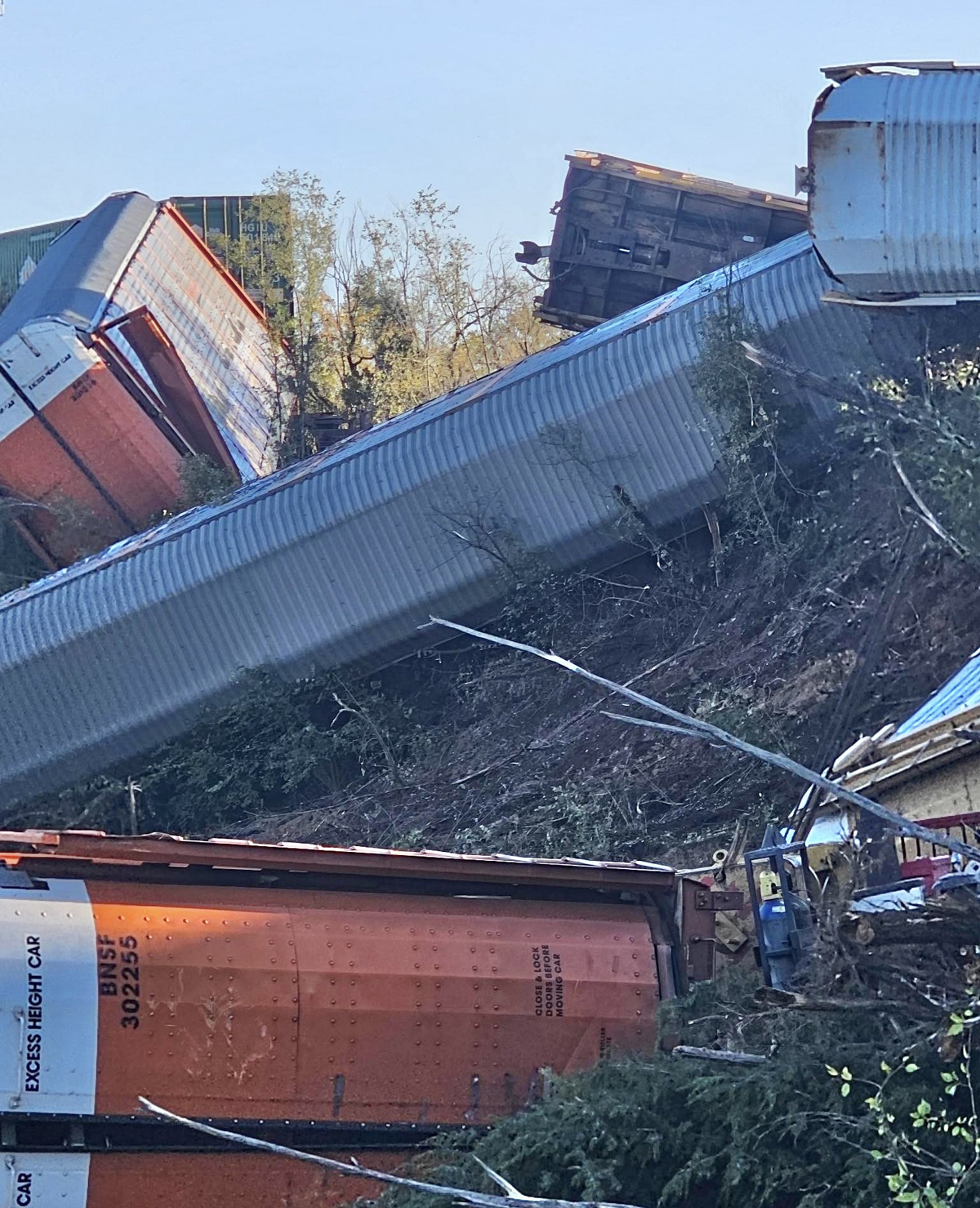
KELSO, Calif. — Union Pacific reopened its Cima Subdivision today less than 26 hours after part of an iron ore train ran away and derailed on the 2.2% Cima Hill grade near Kelso.
“Union Pacific crews worked around-the-clock to rebuild the tracks in the Mojave National Preserve, east of Barstow, where 55 railcars and two locomotives derailed Monday,” UP spokesman Mike Jaixen says. “We anticipate reopening to train traffic this afternoon; however, it will take time to remove all of the cars from the site and complete remediation. We continue to work closely with local, state and federal officials to investigate the cause. As confirmed yesterday, there were no injuries, and the train was carrying iron ore, which is not a hazardous material.”
Train OUTSI-25, which originated in Iron Springs, Utah, with 154 cars of ore destined for export at the Port of Long Beach, Calif., was operating with distributed power in a 2x1x2 configuration, according to a UP train report shared with Trains News Wire.
The train separated between the 55th and 56th cars while on Cima Hill. At some point while the crew was attempting to put the train back together the lead units and 55 cars ran away down the grade. The last GPS report from the lead locomotive showed the train moving at 118 mph, according to a UP document.
UP would not confirm these details about the runaway and subsequent derailment. “Those details are still under investigation,” Jaixen says.
The National Transportation Safety Board is not involved in the investigation.
Heavy bulk trains such as the 21,599-ton OUTSI-25 are limited to 15 mph down the grade, which has claimed other trains over the years. In 1997, a grain train ran away on the grade and reached 72 mph before derailing 68 of its 75 covered hoppers near Kelso. In 1980, three railroaders were killed when a runaway train rear-ended another on the grade, also near Kelso.














I wonder how much money UP saved running that 21,000 ton train on that grade over the last few years? Did it make up for the cost of repairing the track and scrapping the cars and engines. And of course would it have paid for the potential loss of life?
2.2% grade is not steep? You obviously haven’t operated a train in mountain grade territory! In my area we have 2 Subdivision with 2.2% grade ( which is the considered the general ruling mountain grade for most North American railroads ) and systems special instructions for operating in mountain grade territory is to have air set while descending mountain grade if your train is 3500 tons or more and not an empty bulk commodity train. I can tell you at 2.2% grade with all that tonnage behind you even that there is very little room for error when operating in 2.2% grade. If you don’t pay attention to your train handling and don’t have your train under control, even for half a minute, that 20mph max speed becomes 23-24 mph while the excellerometer indicates 18-20 mph more in the next minute if you don’t do something about it! And that’s even with empty bulk commodity trains descending mountain grade without air set! There’s no room for error while operating in mountain grade territory and 2.2% grade is plenty steep with all that tonnage behind you! I run both mountain grade territories here in my area and I can tell you 2.2% grade is nothing to take lightly! We have had plenty of near incidents especially in the winter time!
Mr. Erben, to answer your question, all DPU-equipped locomotives have pressure maintaining, which has been around since 1957 on 24RL brake systems and was designed into the 26L, and most recent DPU-equipped locos have either Knorr/NYAB or WABTEC Fastbrake electronic air brake control systems whose deign interfaces directly with the DPU equipment. Most older locomotives equipped for DPU service that do not have electronic air brakes have either a 26L or 30CDW conventional air brake controls interfaced with an electronic DPU brake system module, which, when configured, bypasses normal conventional air brake operation through the use of push-button air brake controls on the console or control stand.
I have worked with both systems, and trained other LEs and conductors on both systems on simulators and in the field, and the updated older locomotives are compatible in DPU systems with the more recent types. I have been operating DPU-equipped trains since 1973, from the first generation LocoTrol equipment right up to modern Locotrol LEB on conventionally-braked trains and NYAB WireDP in ECP-equipped unit trains in heavy-haul ore train operations. Heavy grade operation has always been a large part of this career mix, which is why I made my original comments on how-to in this situation.
When I worked on QNS&L, the employer made sure everyone was cross-trained to configure and de-configure DPU equipment because we did not always have the luxury of a road foreman of engines or trainmaster to bail us out when things went south. Many of our conductors were qualified LEs as well, and they went to single-person LE-only crews in 1996, abolishing all conductors positions, a year before I left the railroad to work as a regional investigator for the Transportation Safety Board of Canada.
The safe work procedures on heavy grades were well understood, at least in my time working there, and I was familiar with the Kelso accidents, and many others, and UP operating practices due to my work on similar accidents in Canada.
Using DPUs when experiencing a coupler or knuckle failure requires both on-board employees to be qualified LEs, and if you are going to run the split train down the hill in separate sections, you had better know what you are doing to avoid control conflicts and comply with the rules. In this situation the DPU systems must be shut down and both sections operated conventionally and separately by a qualified LE, in effect creating two trains from one for the duration of the planned move, one following the other down the mountain.
I have done this myself on multiple occasions and it is straightforward as long as everyone knows the drill and properly job briefs for the repair, the moves and the join-up to put the train back together before starting. When it is possible to do this, you cut about 90 minutes out the the 5-hour delay a normal doubling of the grade would take.
You still have to secure the train’s two sections with hand brakes use retainers in HP and all the rest of it, but you save enough time to make it worthwhile. I do not recommend running the rear section onto the front section while on the grade to couple up once the repair is done because you cannot check the coupling safely by taking slack and ”checking the pin”.
If there is another crew on a opposing train waiting for you to clean up your mess (and we had enough traffic even with 240-car trains so that it was possible about half the time) they can use their motive power to lend a hand. That cuts the 5-hour delay in half.
If there is no one else around, having an LE-qualified supervisor truck out to give you a hand in the field will shave about thirty minutes off of the normal delay. Where I worked we did not have that option as there were no roads along most of the railroad, especially on the hill, so the supervisors would fly in if daylight and weather permitted and a chopper was available. Not often!
Hope this rather long-winded explanation helps some!
This is a great explanation and I’m sure that most of us TO readers appreciate it. Thanks!
I wonder where the DPU’s were positioned in the train and how they were being handled before the knuckle broke.
Some railroads had/have a pressure maintaining feature on their engines that supposedly accomplished what setting up retainers on the cars does. Does anyone want to comment on this?
The pressure maintaining feature on the locomotive is only to replace the air that leaks out of the train line and therefore maintain the pressure. It has nothing to do with retaining air in the brake cylinders while recharging the brakes.
This strikes me as a Three Stooges affair – whoops – there goes the train! Not very funny, however. Good thing the consist wasn’t a lot of hazmat. What does impress is the chances taken in moving 21,000 tons down 2.2% (which, incidentally, is a significant grade) and the manner in which an attempt was made to double the train – on the side of a grade with known runaway potential. Retainers used to be required on any train with less than one hp/t effective dynamic brake in this territory and may yet. As Mr. Callaghan suggests, the head-end should have been taken down to Kelso (where the 2% grade lessens) and the rear end then brought down and doubled together. There should have been an experienced operating manager on the scene or involved in the procedure, if they are even available any more. I suspect this incident is another example of experience lacking at multiple levels. In any event, it seems the result was a big success story from the fancy picture.
Classed as a Mountain Grade, folks. Pushing 55 loaded ore cars uphill on a 2.2% mountain grade with only 8800 HP is just not possible. At this location, you secure both portions with 100% handbrakes, you recharge the front part of the train in brake pipe air, apply the brakes, remove the handbrakes from the front portion while applying retainers in the 20 LB position on all the cars. Once that is done you can release the air brakes and descend the grade to its’ base, set out the front portion in a siding and secure it with handbrakes, then return to the rear portion, repair the broken knuckle, apply retainers in the 20 LB position, recharge the air brake system, and descend the grade down to where the front portion was set out, re-assemble the train, perform the require air brake tests, and depart. This is a 3 to 5-hour job on this type of grade and train for two persons, even with distributed power. Doing it any other way runs the risk of a runaway. There is NO safe workaround to this to save time.
When the train broke apart, it went into emergency. This creates a reduction in the car reservoirs down to 77 PSI and zero brake pipe pressure. (or in UPs case on this territory. with a 100 PSI brake pipe, 85 PSI) When you recover from the emergency, the car air brake system by design draws air from the car reservoirs to assist in recharging the train brake pipe. This creates a depletion situation throughout the train that negatively affects train air brake response during release and charging and reduces the safety margin significantly until the system has had time to properly recharge in air.
You cannot descend a mountain grade safely in this situation without a properly charged air brake system, relying on the locomotive dynamic brakes to get you down while recharging your air on the fly, you have to do it the hard way and absorb the train and crew delay. The fact that there were no deaths is simply a matter of pure good luck
It would be interesting to listen to the recorded conversations between the crew and the dispatchers and managers in all of this. I have seen far too many of these in my 52 years in railroading to be fooled by UP’s press release. Back to basics for training, safe work procedures on heavy and mountain grades, and air brake systems function knowledge for locomotive engineers and conductors, folks.
Thank you for this clear and comprehensive contribution to the discussion!
Wow.
Who from inside the company pumped allof that information to Trains, or gave it to someone who did?
Aside from the derailment investigation, reopening the tracks in 26 hours after 55 heavy cars go on the ground is absolutely incredible. Good job UP.
118 MPH, we do have high speed rail in CA. Glad nobody was hurt.
It only counts as high speed rail while the wheels were on the rails.
How did it get away? 2.2% isn’t all that steep, but I know they’ve had other runaways there.
Iron ore is dense and heavy and as a result has handling issues on level track.
And why isn’t the NTSB interested in a runaway at a site with frequent runaways. Did they run out of staff with all the derailments?
The train broke in two with two locomotives and 55 cars in the first portion.
After replacing the knuckle the crew tried to push the 55 cars back to a coupling with the rest of the train. This was beyond the capability of the two locomotives on the head-end. In releasing the brakes to push the cars uphill the cars instead began pushing the locomotives downhill. The 55 cars if fully loaded by weight would have weighed nearly 8,000 tons. Well beyond the capability of two locomotives to move up the hill.
2.2% isn’t all that steep? Are you kidding? I think anyone who has worked on the former B&O between Cumberland and Grafton would disagree.
2.2% grade is not steep? You obviously haven’t operated a train in mountain grade territory! In my area we have 2 Subdivision with 2.2% grade ( which is the considered the general ruling mountain grade for most North American railroads ) and systems special instructions for operating in mountain grade territory is to have air set while descending mountain grade if your train is 3500 tons or more and not an empty bulk commodity train. I can tell you at 2.2% grade with all that tonnage behind you even that there is very little room for error when operating in 2.2% grade. If you don’t pay attention to your train handling and don’t have your train under control, even for half a minute, that 20mph max speed becomes 23-24 mph while the excellerometer indicates 18-20 mph more in the next minute if you don’t do something about it! And that’s even with empty bulk commodity trains descending mountain grade without air set! There’s no room for error while operating in mountain grade territory and 2.2% grade is plenty steep with all that tonnage behind you! I run both mountain grade territories here in my area and I can tell you 2.2% grade is nothing to take lightly! We have had plenty of near incidents especially in the winter time!
Moving at 118 mph? This is unimaginable.
Good question Chris. Why aren’t they? Especially in light of all the derailments lately.
It would be interesting to know why the NTSB isn’t involved in the investigation.